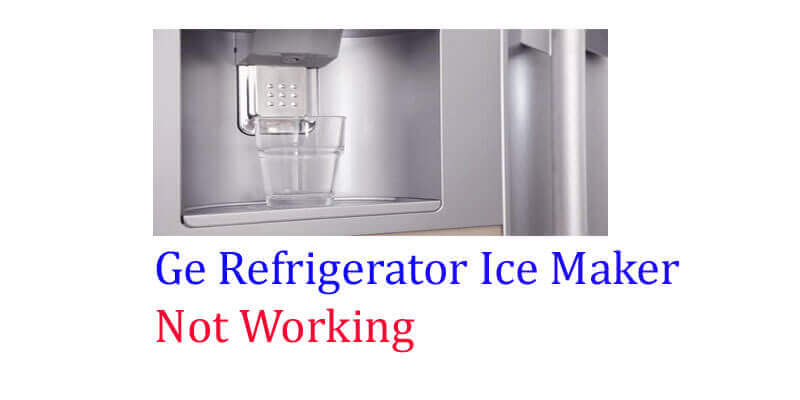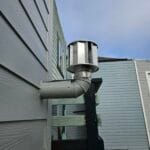The refrigerator ice maker is not working? Check if the water supply line is properly connected and the water filter is clean.
A malfunctioning ice maker can be a hassle for any homeowner. If you’re facing an issue with your ge refrigerator’s ice maker not working, it’s worth taking a few minutes to troubleshoot before calling a repairman. This article will cover the most common reasons why your ice maker may not be producing ice and will provide some simple solutions to fix the problem.
By following this guide, you can save yourself time and money and have your ice maker running smoothly again in no time.

Common Causes Of A Malfunctioning Ice Maker
A refrigerator ice maker is an indispensable appliance in the kitchen. When it malfunctions, it can disrupt your daily routine and lead to food waste. In this section of the blog post, we will discuss the common causes of a malfunctioning ice maker.
Lack Of Power Supply
The first thing to check when your ice maker stops working is the power supply. Here are some key points to consider:
- Ensure that your refrigerator is plugged in and that the outlet has a power supply.
- Check if there are any tripped breakers or fuses.
- Make sure the ice maker switch is turned on.
Clogged Water Filter
A clogged water filter can obstruct the water flow and cause issues with the ice maker. Here are some key points to remember:
- Replace the water filter every 6 months or when it becomes clogged.
- Follow the manufacturer’s instructions on how to change the water filter.
- If the ice maker is still not working after replacing the filter, check the water inlet valve.
Malfunctioning Water Inlet Valve
The water inlet valve controls the water flow that enters the ice maker. Here are some key points to remember:
- Check the water inlet valve for any signs of damage or wear.
- Follow the manufacturer’s instructions on how to troubleshoot and replace the valve.
- If the valve is faulty, it can lead to overfilling or no water flow.
Faulty Ice Maker Assembly
A faulty ice maker assembly can cause issues with ice production. Here are some key points to remember:
- Check if the ice maker assembly is properly aligned and fitted.
- Clean the ice maker assembly periodically to prevent clogs.
- Follow the manufacturer’s instructions on how to replace the ice maker assembly.
Incorrect Freezer Temperature
The freezer temperature plays a crucial role in ice production. Here are some key points to remember:
- Ensure that the freezer temperature is set between 0 to 5 degrees Fahrenheit.
- Check the freezer temperature periodically to prevent ice maker issues.
- If the temperature is too high or too low, it can affect ice production.
Steps To Check Power Supply Issues
Checking Power Cords And Outlets
The first step in checking power supply issues on a ge refrigerator ice maker is to examine the power cords and outlets. Here are the key points to keep in mind:
- Unplug the refrigerator and check the power cord for any visible signs of damage, such as cuts, frayed wires, or burn marks.
- If the power cord appears to be in good condition, plug it into a different outlet to confirm that the problem isn’t with the outlet.
- Make sure the outlet is working correctly by plugging in another appliance or device, such as a lamp or phone charger.
- If the power cord or outlet is damaged, replace it with a new one before continuing to troubleshoot the ice maker.
Testing Electrical Connections And Switches
The second step in checking power supply issues is to test the electrical connections and switches on the ice maker. Follow these steps:
- Locate the ice maker in the freezer compartment and unplug it from the power source.
- Remove the cover panel on the front of the ice maker to access the electrical connections and switches.
- Check the wires and connections for any signs of damage, corrosion, or loose connections. Tighten any loose connections and replace any damaged wires.
- Use a multimeter to test the continuity of the electrical connections and switches. Follow the manufacturer’s instructions for using the multimeter.
- If any components fail the continuity test, replace them with new ones before reassembling the ice maker.
By following these steps to check power supply issues on a ge refrigerator ice maker, you can eliminate potential causes of the problem and determine if further troubleshooting is necessary.
Steps To Troubleshoot Clogged Water Filter
Ge Refrigerator Ice Maker Not Working
Are you facing an issue with your GE refrigerator ice maker? Is it not producing ice as it usually does? One common reason for this problem may be a clogged water filter. Here are some easy steps to troubleshoot this issue.
Identifying The Water Filter Location
- Outdated ge refrigerators have a water filter located in the back of the refrigerator, at the bottom, or in the top-right corner of the refrigerator compartment.
- Newer models have a water filter located in the left upper back corner of the refrigerator compartment or a bypass plug that replaces the filter permanently.
How To Replace The Water Filter
- Turn off the ice maker by raising the wire signal arm.
- Locate the water filter through the instructions given in your freezer manual.
- Before replacing the filter, either remove the old filter or use the bypass plug that came with the refrigerator.
- Gently insert the new filter and turn it clockwise until it clicks into place.
- Turn on the ice maker by lowering the wire signal arm.
- Hold the water dispenser for five minutes until the water flows out smoothly.
Running Water Through The Filter To Flush Out Debris
- Before installing a new filter, it is advisable to run water through the filter to get rid of any loose carbon bits that may be present.
- Turn off the ice maker by raising the wire signal arm.
- Locate the filter and remove it.
- Run water through it for two minutes from the back of the filter to flush out any debris.
- Reinstall the filter following the instructions given in your freezer manual.
- Turn on the ice maker by lowering the wire signal arm.
By following these straightforward steps, you can troubleshoot a clogged water filter issue and get your ge refrigerator’s ice maker working smoothly once again.
Steps To Diagnose Water Inlet Valve Problems
If you own a ge refrigerator and the ice maker isn’t working, the issue could be with the water inlet valve. The water inlet valve allows water to enter the refrigerator and supply the ice maker. If it fails, your refrigerator’s ice maker won’t work.
Don’t worry; you can easily diagnose the problem by following these simple steps.
Identifying The Valve Location
The water inlet valve is located at the bottom of the refrigerator. You need to remove the bottom access panel to reach the valve. The location of the panel might be different depending on your refrigerator’s model. However, you can use the owner’s manual or search online to find the location of the panel.
Once you remove the panel, you can see the water inlet valve.
Testing The Water Inlet Valve For Continuity
The best way to test the water inlet valve is to check whether it has continuity using a multimeter. If the valve has continuity, it means it’s working fine, and the problem is with some other component. If it doesn’t have continuity, you need to replace it.
To test the valve, follow these steps:
- Disconnect the power source of the refrigerator.
- Remove the wires attached to the valve’s terminals.
- Set the multimeter to the ohms setting.
- Touch the probes of the multimeter to the terminals of the valve.
- Check the multimeter reading. If it shows zero ohms or close to zero, the valve has continuity. If it shows infinite ohms or no reading, the valve doesn’t have continuity, and you need to replace it.
Replacing The Valve If Necessary
If the water inlet valve doesn’t have continuity, you need to replace it. Here’s how:
- Turn off the water supply and unplug the refrigerator.
- Remove the wires connected to the valve’s terminals.
- Remove the valve’s mounting screw or bracket.
- Take out the valve.
- Install the new valve in the same position as the old one.
- Reattach the mounting bracket or screw.
- Reconnect the wires to the terminals.
- Turn on the water supply and plug in the refrigerator.
By following these steps, you can easily diagnose and fix the water inlet valve problem. In case you face any issues, always consult the owner’s manual or seek professional help.
Steps To Fix Faulty Ice Maker Assembly
Ge refrigerator ice maker not working can be stressful, especially when it’s required for your daily routine. The good news is, that most ice maker assembly issues can be fixed in a few simple steps. Here are some steps to fix a faulty ice maker assembly.
Checking For Proper Alignment Of The Ice Maker
- Look for any loose or damaged connections.
- Check if the ice maker is level, and adjust it accordingly.
- Inspect the ice maker’s mounting brackets and ensure they are correctly positioned.
- Check if the freezer temperature is appropriate.
Inspecting The Water Supply Line And Fill Tubes
- Ensure the water supply valve is turned on.
- Check for any kinks or damage to the water supply line.
- Inspect the fill tubes for blockages or damage; clean or replace them as needed.
Ensuring The Ice Maker Is Receiving Power
- Check if the power switch of your refrigerator is turned on.
- Inspect the ice maker’s wiring harness and ensure that it is correctly connected.
- Use a multimeter to check if the ice maker is receiving power.
Remember, always unplug your refrigerator before attempting any repairs to avoid any accidents. If you have tried all of these steps and your ice maker still isn’t working, it may be best to call a professional repair service. Hopefully, these tips helped you fix your ice maker and get it back in working condition.
Adjusting Freezer Temperature For Optimal Ice Maker Performance
Ge Refrigerator Ice Maker Not Working
Are you having problems with your GE refrigerator’s ice maker? A common issue that many ge refrigerator owners experience is subpar ice production, which can be due to improper temperature control in the freezer. In this blog post, we will discuss how you can adjust the freezer temperature for optimal ice maker performance and get your ice maker back to working correctly.
Ideal Freezer Temperature For Ice Production
The ideal temperature for the freezer in your GE refrigerator should be set between 0-5 degrees Fahrenheit to achieve optimal ice production. Anything higher will cause your ice maker to produce less ice, which could be frustrating if you frequently need ice.
Lowering the temperature might create ice too hard to break or make.
Steps To Adjust The Freezer Temperature
To adjust the freezer temperature on your refrigerator, follow these simple steps:
- Locate the temperature control dial. It’s usually found inside the refrigerator’s fresh food compartment.
- Turn the dial to lower the temperature in the freezer.
- Wait for the temperature to adjust to the new setting.
- Observe the ice production over the next 24 hours or so to see if there’s any improvement.
- If necessary, make further adjustments until you reach the ideal temperature range.
Keep the freezer closed as often as possible to help maintain consistent temperature levels, and make any adjustments slowly to avoid overshooting the ideal temperature range.
Importance Of Proper Temperature Control
Proper temperature control is imperative for optimal ice maker performance in your ge refrigerator. If the temperature is too high, the ice maker will not produce as much ice as it could have. In contrast, setting the temperature too low might make it harder for the ice to release from the ice maker tray.
This could result in clumped ice, reduced ice production, and even a splash of water that will cause the ice to stick together.
Invest in a thermometer that you can place in your ge refrigerator to monitor the temperature range in the freezer. Paying attention to temperature changes and taking proactive measures is the best way to avoid ice maker troubles.
If your GE refrigerator’s ice maker isn’t producing enough ice, it might be a sign of improper temperature regulation. By adhering to the ideal temperature range and adjusting the temperature gradually, you can improve the ice maker’s performance significantly. Remember to keep your freezer door closed as often as possible and monitor temperature changes with a thermometer to prevent any further ice maker issues.
Frequently Asked Questions
Why Is My Ge Refrigerator Ice Maker Not Making Ice?
If the ice maker is not making ice, there could be a problem with the water supply, the freezer temperature, or the ice maker itself.
How Do I Troubleshoot My Ge Refrigerator Ice Maker?
To troubleshoot your ge refrigerator ice maker, check the temperature, water supply, and power connections. Also, make sure the ice maker is turned on.
How Do You Reset The Ice Maker On A Ge Refrigerator?
To reset the ice maker on a ge refrigerator, find the power switch or unplug the unit for a few minutes. Then, turn the power back on.
What Do I Do If My Ge Refrigerator Ice Maker Is Leaking?
If your ge refrigerator ice maker is leaking, check the water supply line and ice maker assembly for any leaks or loose connections.
How Long Does It Take For A Ge Refrigerator Ice Maker To Make Ice?
It can take up to 24-48 hours for a ge refrigerator ice maker to make its first batch of ice. After that, it should produce ice regularly.
Conclusion
A malfunctioning GE refrigerator ice maker is a common problem that can be frustrating to deal with. We’ve covered several potential causes of the issue, including frozen water lines, faulty ice maker components, and improper settings. During your troubleshooting process, it’s important to keep safety in mind and to consult with a professional if necessary.
Remember to check your owner’s manual for specific instructions and to schedule regular maintenance to prevent future problems. By following these tips and staying proactive with your refrigerator care, you can ensure that your ge refrigerator ice maker is working properly and keeping your drinks and food cooled just as they should be.
Don’t let a pesky ice maker issue ruin your day – with a bit of patience and persistence, you can get back to enjoying your kitchen in no time!





